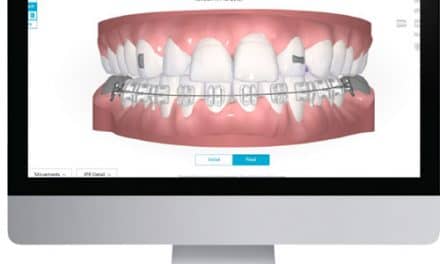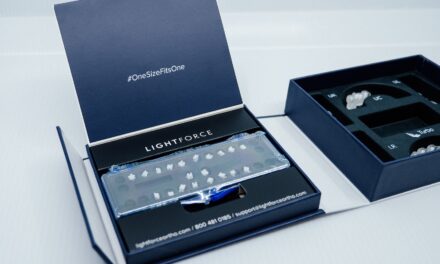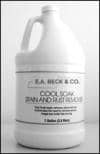by Aldo Carano, Dr Odont, MS, Spec Orthod?, Carolina Mannarini, DO, and S. Jay Bowman DMD, MSD
| Figures 1a-b: The solution.
Figures 2a–d: Application of composite anterior bite planes. Figures 3a-g: Patient with a Class II Division 1 transitional Figures 4a–b: Patient with Class II Division 2 malocclusion and low-angle growth pattern. |
Correction and retention with permanent bite planes Deep bite correction essentially involves intrusion of anterior teeth, extrusion of posterior teeth, or some combination of the two. The type of movement that occurs during orthodontic treatments depends upon management of the occlusal-plane inclination, the amount of mandibular growth, the vertical dimension that the orthodontist desires at the end of the treatment, and the smile line.1–4 Burstone5 proposed six guidelines for incisor and canine intrusion: 1) the use of optimal forces with low elastic modulus (low stress/strain ratio); 2) a single point of application of the force in the anterior region; 3) proper selection of this force-application point related to the center of resistance of the anterior teeth; 4) selective intrusion dependent upon the relative inclination of the incisors; 5) posterior anchorage control; and 6) inhibition of unwanted extrusions. In accordance with these guidelines, the use of lingual brackets on maxillary incisors has been proposed to open the bite during typical fixed-appliance therapy (that is, edgewise brackets on the buccal surfaces).6,7 The contact of lower incisors on the upper-lingual brackets produces intrusive forces both on the upper and lower incisors, while a lack of posterior contact permits some extrusion.6 Forces exerted are more physiologic, produced by patient musculature and normal function, with the force line of action closer to the center of resistance of the incisors. Consequently, intrusion appears to be more bodily than tipping in nature. Deep-bite correction by lingual bracket bite plane occurs gradually, 1 mm of intrusion per month, but this is often faster than other methods. The rate of intrusion depends on the force characteristics and also on the possibility of simultaneous application of edgewise brackets on lower teeth. Unfortunately, prefabricated lingual bite planes are typically contraindicated for patients with greater than 4 mm of overjet, as the mandibular incisors would occlude lingual to the bite plane. An advantage of the simple fixed bite plane is in retention. Deep bites have a strong disposition to relapse soon after treatment is completed and during retention.8 This undesired eruption of the incisors, with or without a partial intrusion of the molars, is often responsible for other types of relapse, such as lower crowding, increase in overjet, and loss of Class II correction. Consequently, the vertical stability of the incisors might be fundamental to ensuring the long-term results of a finished orthodontic case. One method of ensuring the stability of the deep-bite correction is changing the anatomy of the maxillary incisors. The mandibular incisors slide along the slope of the lingual anatomy of the maxillary incisors during the return of a deep bite (Figure 1a, page 42). By changing the slope to a horizontal platform, the incisors become locked into that vertical dimension (Figure 1b, page 42). Unfortunately, lingual brackets or pre-formed lingual bonded attachments are not advisable to use for long-term retention due to their discomfort and potential for casting some grey shadow through translucent enamel. They are not easily adjustable to the occlusion, and oral hygiene can also be problematic. The purpose of this article is to describe the development of a simple method of bite opening fixed, composite bite plane placed on the lingual surfaces of maxillary incisors and canines. This method is easy, inexpensive, adjustable, and effective; and it is possible to maintain the composite bite plane for long-term retention. Materials and Methods The method proposed for deep-bite correction consists of building composite bite plane on the lingual surfaces of the maxillary incisors and, occasionally, the canines. The bite planes are constructed approximately 2 mm from the incisal edge (Figures 2a–2c, page 42) using self-curing or light-activated composite resin. A double-paste composite or light-cure adhesive, commonly used in orthodontic bonding, is applied to the lingual surface of a tooth in sufficient amount to build the bite plane. A miniature sponge applicator, dipped in liquid primer, is used to sculpt the bite plane at the incisal third of tooth. The sponge produces a smooth surface for the bite plane. Any necessary finishing or refinement of the bite plane is done using a high-speed dental handpiece with a green stone. Articulating paper is used to mark any high spots for adjustment of the fit of the mandibular teeth on the bite planes. Unlike lingual brackets or prefabricated bite planes, composite bite plane can be used in the presence of severe overjet. Composite bite planes are formed with a greater labio-lingual dimension, which is progressively reduced—with a handpiece and bur during resolution of the overjet—to a smaller size for long-term retention. Often, an occlusal stop on the canines is also recommended for patients with severe overjet. Case 1 An adolescent patient presented with a Class II Division 1 malocclusion with a deep bite and a high-angle growth pattern (Figures 3a and 3b). Initial correction was achieved with composite bite planes constructed on the lingual surface of the maxillary incisors (Figures 3c and 3d). The sagittal discrepancy was then treated using typical preadjusted appliances on the maxillary teeth. The completed result was retained using a maxillary Hawley retainer that was modified to avoid the composite bite planes (Figures 3e and 3f). The case was stable after complete eruption of permanent teeth was achieved 3 years post-treatment (Figure 3g). Case 2 An adult patient presented with a Class II Division 2 malocclusion and a significantly deep bite. The sagittal discrepancy was treated using fixed-functional auxiliaries with bonded, preadjusted appliances. The deep bite was corrected using four composite bite planes constructed on the lingual surface of the maxillary incisors. These bite planes were modified to include a lingual wire and left in place during retention. A section of stainless-steel ligature wire (0.10) was folded over itself and then, with needle holders at each end, the two strands were twisted around each other. A narrow mesiodistal trench was cut through each bite plane using a diamond bur. The twisted, dead-soft wire section was then placed into the trough before additional composite was used to refill the trench (Figure 2d). Case 3 An adolescent patient presented with a Class II Division 2 malocclusion and a low-angle growth pattern (Figure 4a). Maxillary molar distalization to a Class I molar relationship was achieved using a fixed device to push molars distal into Class I, followed by preadjusted appliances. The deep bite was corrected using four composite bite planes fabricated on the lingual surfaces of the maxillary incisors. Treatment was completed in 19 months. The bite planes were left in place for long-term retention with favorable post-treatment stability (Figure 4b). Discussion and Conclusion The bite-plate effect of lingual brackets is well known. Mandibular incisor occlusion on maxillary incisor lingual brackets generates intrusive forces on anterior teeth, while posterior disclusion permits tooth extrusion.6 Combining lingual brackets or composite bite planes on maxillary incisors, along with typical edgewise appliances, enhances rapid correction of deep bite. Unlike other intrusive mechanics, lingual bite planes produce a physiologic, intrusive force, generated by patient musculature, and the force application is closer to the long axis (through the center of resistance of the incisors). This type of intrusion occurs automatically, independent from clinical activation of archwires or mechanics that require dental anchorage or extraoral traction. If TMD symptoms are apparent, bite planes are feasible only if the primary etiology is muscular. Intra-articular symptoms often require posterior bite plates in addition to the anterior ones.9,10 In terms of TMD risk, once incisor intrusion has been accomplished with an upper anterior bite plane, then posterior teeth have also often erupted to contact. In this manner, the anterior bite planes merely act as occlusal stops without further change in vertical dimension and/or TMJ function. Another advantage of using composite fixed bite planes is that they may be used for long-term retention. Relapse of deep bite is a common finding over time as the incisors erupt and slide past one another. Contributing factors for relapse are occlusal and masticatory forces along with tongue pressure, often tending to procline the maxillary incisors. In addition, posterior extrusion may relapse as well. These factors, in concert, may contribute to the redevelopment of an overbite. Perhaps one of the easiest methods of achieving stable bite opening is to modify the lingual surface of the maxillary incisors by adding composite bite planes and maintaining them during long-term retention. z Aldo Carano, Dr Odont, MS, Spec Orthod, was in the private practice of orthodontics in Taranto, Italy. He was an adjunct associate professor at St Louis University and a visiting professor at the University of Ferrara. ?Deceased. Carolina Mannarini, DO, is a resident at the University of Ferrara. S. Jay Bowman, DMD, MSD, is in the private practice of orthodontics in Portage, Mich. He is an adjunct associate professor at St Louis University and the Straightwire instructor at the University of Michigan. He can be reached at [email protected].
|
|
References 1. Schudy FF. The control of vertical overbite in clinical orthodontics. Angle Orthod. 1968;38:19–38. 2. Ricketts RM, Bench RW, Gugino CF, Hilgers JJ, Schulhof RJ. Bioprogressive Therapy. Book 1. Denver, Co: Rocky Mountain Orthodontics; 1979:25. 3. Engel G, Cornforth G, Damerell JM, et al. Treatment of deep-bite cases. Am J Orthod. 1980;77:1–13. 4. Dellinger EL. A histologic and cephalometric investigation of premolar intrusion in the Macaca speciosa monkey. Am J Orthod. 1967;53:325–355. 5. Burstone C. Deep overbite correction by intrusion. Am J Orthod. 1977;72:1–22. 6. Gorman JC, Smith RJ. Comparison of treatment effects with labial and lingual fixed appliances. Am J Orthod Dentofacial Orthop. 1991;99:202–209. 7. Carano A, Ciocia C, Farronato G. Use of lingual brackets for deep bite corrections. J Clin Orthod. 2001;35:449–450. 8. Carano A. Strategie ortognatodontiche di finalizzazione nei pazienti adulti disfunzionali. Ortognatodonzia Italiana. 1999;8(4):453–463. 9. Sadowsky C, Sakols EI. Long-term assessment of orthodontic relapse. Am J Orthod Dentofac Orthop. 1982; 82:456-463. 10. Carano A, Leone P, Carano A. Orthodontic strategies in adult dysfunctional patients. J Craniomand Pract. 2001;19: 195–213. |
|



















